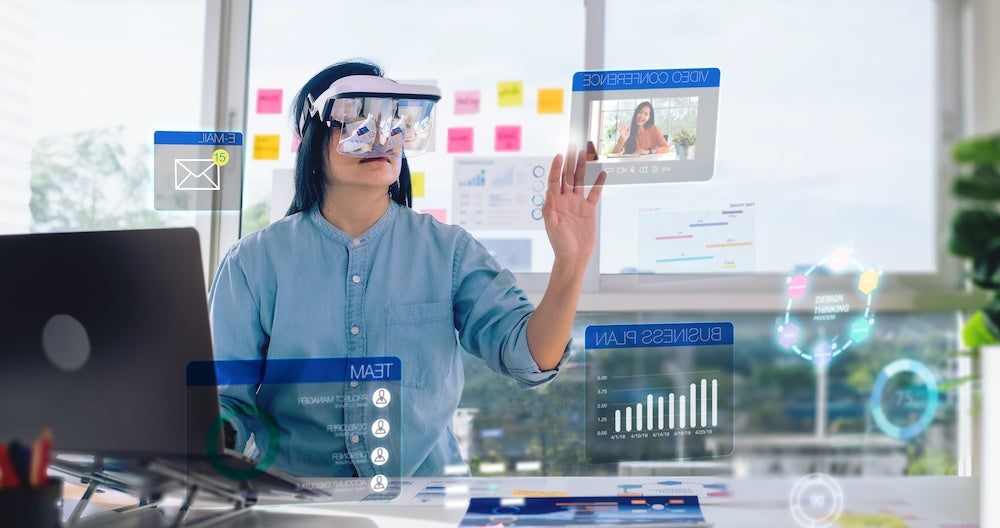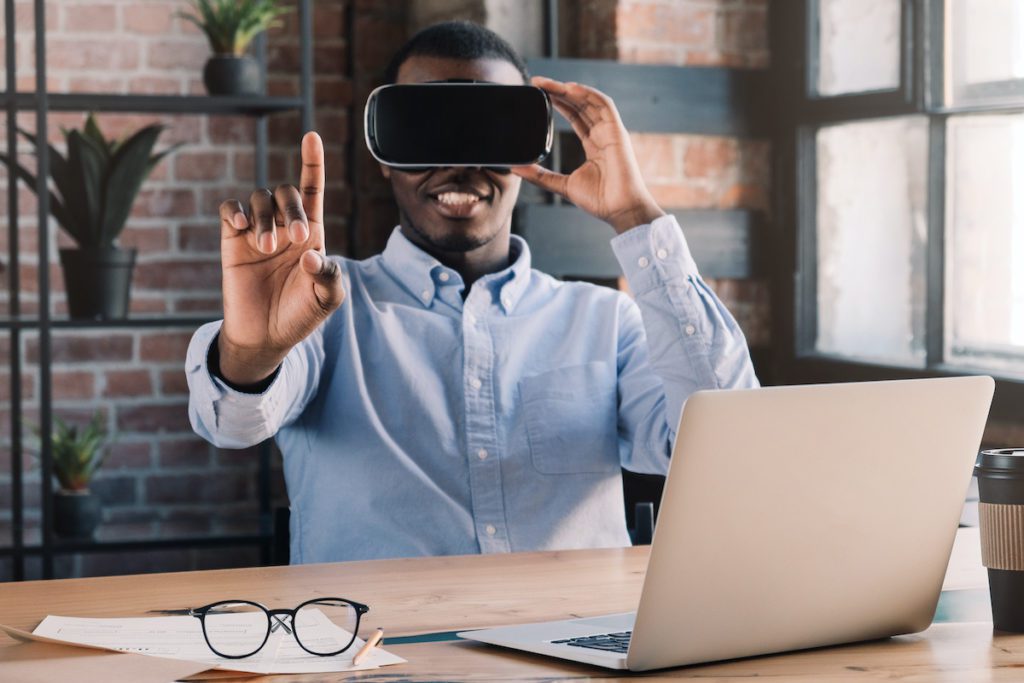Last spring, video game maker Epic Games broadcasted rap artist Travis Scott’s “Astronomical” virtual reality (VR) concert live from within its immensely popular game, Fortnite. It is estimated that approximately 12.3 million people viewed the concert from within the game, while millions more watched encores on YouTube.
The Scott VR concert is testament to the shifting winds that the COVID-19 pandemic has brought in its wake. Immersive technologies — augmented reality (AR), VR, mixed reality (MR), and extended reality (XR) — once slow to catch on, have achieved some maturity as forced isolation has rewritten the script on human contact. MR, the younger sibling to AR, has been especially impactful with its ability to merge real and virtual worlds to build interactive environments that blend real and digital objects using headsets.
Table of Contents
- Mixed Reality: Immersive Tech’s Rising Star
- Reshaping Work with Immersive Tech
- Immersive Tech Integration
Immersive tech’s big moment is yet to come, but its anticipated convergence with AI and push with 5G are poised to usher AR, VR, MR, and XR into the mainstream. What does the emergence of immersive tech mean for digital business transformation, especially as the workforce grows more comfortable with working remotely? And how will immersive technology powered by AI and 5G reshape the workplace experience?
Also read: How AI Will Be Pushed to the Very Edge
Mixed Reality: Immersive Tech’s Rising Star
In 2020 Microsoft and the Harvard Business Review Analytic Services released Mixed Reality: A New Dimension of Work, an examination of the role and importance of mixed reality in the modern workplace across a range of industries, from manufacturing, engineering, and construction to retail, defense, and education. The survey noted that 68 percent of businesses believe mixed reality is important to fulfilling company strategic goals. Nearly 90 percent are currently exploring, piloting, or deploying mixed reality, with a third of this number already putting mixed reality into production this year. The survey acknowledges that the technology is still young, but the benefits of mixed reality are already emerging. According to the survey:
- 62% of businesses expect improved customer satisfaction
- 55% of businesses expect to see the emergence of efficient work processes
- 52% anticipate a competitive advantage
- 47% predict improved customer service
- 37% anticipate reduced costs
The automotive industry, long before the pandemic, has led in use cases of mixed reality, but other businesses sectors, including communications and retail, have recognized its implementation as part and parcel to successfully launching digital transformation initiatives. This push is reflected in the number of mixed reality headsets and devices that have gained traction in the past year, including Google Glass, Microsoft’s HoloLens, and Sony’s PSVR.
Reshaping Work with Immersive Tech
The growing business interest in immersive technology is in part due to the ever-growing remote workforce and the reduced costs of MR headsets, displays, and devices. With the loss of physical interaction, businesses have had to rethink collaboration, productivity, and socialization, including ways to to keep employees focused and engaged. Mixed reality’s newfound footing in both small and enterprise businesses shows that pandemic-induced restrictions have had their benefits, especially when it comes to reimagining traditional in-person activities such as work events and conferences and workforce training.
AI and machine learning have been central to immersive technology and will likely bring evolutionary changes to AR and VR collaborative workspaces, with improved human motion and movement without coding — something that is being developed more aggressively in the gaming industry — to bring deeper immersion and better interaction.

Similarly, 5G, with its promise of higher bandwidth, lower latency, and unheard-of-before connectivity, will temper some of immersive technology’s more irksome latency and bandwidth-hogging problems, while enabling greater data transfer speeds and AI functionality — the building blocks of better interactive environmental design and emotional learning within VR, AR, and MR.
Also read: AI to Become Mainstream in 2021
Workplace Events and Conferences
The greatest impact of immersive technology has been felt in conference and collaboration spaces. In addition to a reduction in travel expenses, immersive technology allows for greater flexibility for how teams meet and interact. This extends to collaboration and project management, where real-time workflows can be streamlined with virtual prototypes, plans, and processes that allow for failure and quick recovery at little or no cost.
The growing interest in virtual collaboration spaces has raised the profile of SaaS-based companies like Spacial and Microsoft-owned AltSpaceVR (free to use) that offer everything from lifelike avatars to three-dimensional work environments while using a wide gamut of headsets.
Last fall, for example, the Global HR Summit, showcasing how immersive technologies can enable digital transformation, was hosted on AltSpaceVR. The three-day event featured 50 speakers wearing Oculus Quest headsets while virtual attendees had the option to don their own headsets for an immersive experience or simply use their laptop for the 2D view. Headsets were shipped out to all 50 speakers by summit partners Genius Ventures and Bento HR, who noted that the costs were significantly less than flying speakers out, providing accommodations, and other conference-related expenses.
Enterprise Training

As a training solution for a disparate workforce, mixed reality allows for the virtualization of coursework while affording trainees the ability to interact with physical aspects of the environment. The benefits have in some cases been profound, as users wearing headsets are able to simulate entire procedures and processes while interacting with 3D objects and overlaid real-world instruction manuals and guides. Such innovative immersion techniques challenge traditional static learning methods while providing stimulating engagement and cost efficiency. And without the need to travel, provide a trainer, source practice equipment, and allocate training space, companies turning to immersive tech have a built-in return on investment.
In 2018, Walmart illustrated the best use case for immersive tech for training when it acquired 17,000 Oculus Go entry-level headsets to train more than 1,000,000 employees on 45 activity-based modules built on STRIVR software. The initiative sought to deliver realistic, repeatable, and scalable training content, to help Walmart associates learn information more quickly and retain it better.
“The great thing about VR is its ability to make learning experiential,” said Andy Trainor, Walmart’s senior director of Walmart U.S. Academies. “When you watch a module through the headset, your brain feels like you actually experienced a situation. We’ve also seen that VR training boosts confidence and retention while improving test scores 10 to 15 percent – even those associates who simply watched others experience the training saw the same retention boosts.”
Immersive Tech Integration
With the pandemic as a catalyst, immersive technologies enter 2021 ahead of their growth projections, but challenges still remain. While AR, VR, and MR got some much-needed attention as work went remote, there are still significant gaps in the user experience and understanding of their capabilities. Alongside the initial costly output for devices and 3D environment design, enterprises seeking to build business models on what are still relatively new technologies are also justifiably nervous to take the leap.
2021 is predicted to be pivotal in the adoption of immersive technologies, according to the Capgemini Research Institute, which outlined four strategies for overcoming the challenge of integrating enterprise immersive tech:
- Develop centralized business models that promote and manage your organization’s immersive technology investment
- Invest in an in-house team to enable future adoption
- Determine the right use case for you business to provide lasting value and support for employees
- Prepare your IT infrastructure to integrate immersive technology with existing technologies.
As models of what it means to be at work undergo constant change, now is the time to establish stabilizing workflows that continue to engage employees while attracting new hires. Immersive technologies are already finding functionality in enterprise environments, and with the coming evolution of the network thanks to 5G and the convergence with AI, these technologies are banding together to remake the workplace experience in positive ways.
Also read: The Best Tools to Successfully Train Remote Employees


